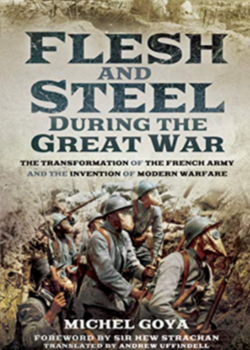Flesh and Steel during the Great War. The Transformation of the French Army and the Invention of Modern Warfare by Michel Goya.
- Home
- World War I Book Reviews
- Flesh and Steel during the Great War. The Transformation of the French Army and the Invention of Modern Warfare by Michel Goya.

£25.00, Pen & Sword, 323pp, index, notes and refs.
ISBN: 9781473886964.
Michel Goya served in the French Army from 1983 to 2009. His considerable operational experience has strongly influenced his writing. His aim in Flesh and Steel is to explain how an army of millions of men was transformed in four years. Goya draws on three sources: the archives of the French Army Historical Branch in Vincennes (for the perspective of the high command), the works of pre–war theorists and veterans (including two who analysed the operations of the 13th Infantry Division throughout the war) and finally, French military regulations, with a particular slant on the difference between theory and practice, which he also observed throughout his own career.
He begins with the fallout from France’s defeat in 1870–71, after which the army and the new French Republic had to construct a relationship. This was difficult and the state of flux at the top levels of army and government hindered consistent planning. At the same time, the army had to re–educate itself. Two factions had developed which tended to emphasise either élan or matériel to an extreme. By 1914 the élan school was in the ascendancy – though the practice of l’offensive à l’outrance in August 1914 differed from the theory. Thus, factional diversity before the war diluted the ability of the high command to impose a doctrine, leaving aside the question of what the army could actually do compared to what it was intended to do.
There was a fascinating moment in 1914 when the French Army made radical changes to its fighting style. The disastrous Battles of the Frontiers were characterised by unsupported bayonet charges. By the Battle of the Marne two weeks later, the French had developed new tactics dominated by the deployment of the now famous ‘75s’. These ultimately blunted German attacks and forced them to withdraw. Joffre also sacked many ‘incompetent’ officers and promoted those who had proved themselves in ‘the test of fire’.
All the arms had to develop new techniques – infantry, artillery, cavalry, the air and assault artillery, and tanks. New equipment, enemy actions and availability of manpower all played their part – as did differing views within the officer corps. The idea that ‘artillery conquers, infantry occupies’ was by no means universally held even in 1918. Many officers felt that it was unfortunate to tie the infantry to rolling barrages as this would stifle initiative – a view that crops up frequently in the French tactics debate right through to 1945.
Change not only rose from the bottom up. From the beginning of the war GHQ tried to understand what was happening, learn lessons and draw up fresh directives. Gradually a gulf was created between what GHQ felt the troops should do and what the troops wanted to do. Goya suggests that Pétain’s appointment to supreme command after the ‘mutinies’ was significant because he involved himself in implementing change, while Joffre had left subordinates and the arms to manage it.
In Chapter 9 the author leads us into the ‘Death Zone’ with a forensic examination of the ‘life and death problems’ that, primarily, confronted the infantry. He cites a variety of memoirs by French veterans published in the 1920’s and 30’s as well as works by Richard Holmes, Rommel’s Infantry Attacks and Jünger’s Storm of Steel. In contrast to the infantry, losses in the artillery were proportionately much lower. As highly trained technicians they were better enabled to get to grips with the many new weapons and techniques, both in their arms and the air.
Co–ordination between government, industry and army produced the first tanks in just ten months. The process was neither smooth nor efficient and, as in the British Army, the tanks had to gain the confidence of the infantry and artillery. This was partially achieved at Malmaison in October 1917, but tanks became much more prominent during 1918. Whereas the British usually deployed relatively small numbers of heavy tanks (Cambrai or Amiens were exceptions) the French deployed thousands of small Renault tanks to support their infantry with numbers. The Renaults were much more mobile both on the battlefield and operationally since they could be transported by lorry.
The French perspective of the Great War has rarely been available to English speaking readers. Pen & Sword are therefore to be congratulated for translating this important and exciting book. Goya’s style is highly readable. His views are backed up by both case studies and statistics. Anyone with an interest in the Western Front should read this book. It will open many eyes to those millions who served in horizon blue.
Review by Andy Grainger
[This review first appeared in Stand To! January 2021 No. 121. Members receive the journal of The Western Front Association Stand To! three times a year as well as three issues of its member-magazine Bulletin each year].





